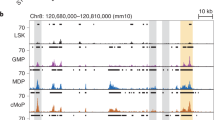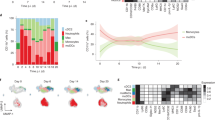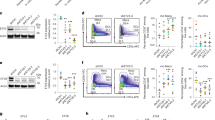Abstract
The transcription factors that regulate differentiation into the monocyte subset in bone marrow have not yet been identified. Here we found that the orphan nuclear receptor NR4A1 controlled the differentiation of Ly6C− monocytes. Ly6C− monocytes, which function in a surveillance role in circulation, were absent from Nr4a1−/− mice. Normal numbers of myeloid progenitor cells were present in Nr4a1−/− mice, which indicated that the defect occurred during later stages of monocyte development. The defect was cell intrinsic, as wild-type mice that received bone marrow from Nr4a1−/− mice developed fewer patrolling monocytes than did recipients of wild-type bone marrow. The Ly6C− monocytes remaining in the bone marrow of Nr4a1−/− mice were arrested in S phase of the cell cycle and underwent apoptosis. Thus, NR4A1 functions as a master regulator of the differentiation and survival of 'patrolling' Ly6C− monocytes.
This is a preview of subscription content, access via your institution
Access options
Subscribe to this journal
Receive 12 print issues and online access
$209.00 per year
only $17.42 per issue
Buy this article
- Purchase on Springer Link
- Instant access to full article PDF
Prices may be subject to local taxes which are calculated during checkout








Similar content being viewed by others

References
Martínez-González, J. & Badimon, L. The NR4A subfamily of nuclear receptors: new early genes regulated by growth factors in vascular cells. Cardiovasc. Res. 65, 609–618 (2005).
Lim, R.W., Varnum, B.C. & Herschman, H.R. Cloning of tetradecanoyl phorbol ester-induced 'primary response' sequences and their expression in density-arrested Swiss 3T3 cells and a TPA non-proliferative variant. Oncogene 1, 263–270 (1987).
Hazel, T.G., Nathans, D. & Lau, L.F. A gene inducible by serum growth factors encodes a member of the steroid and thyroid hormone receptor superfamily. Proc. Natl. Acad. Sci. USA 85, 8444–8448 (1988).
Moll, U.M., Marchenko, N. & Zhang, X.K. p53 and Nur77/TR3—transcription factors that directly target mitochondria for cell death induction. Oncogene 25, 4725–4743 (2006).
Li, Q.X., Ke, N., Sundaram, R. & Wong-Staal, F. NR4A1, 2, 3—an orphan nuclear hormone receptor family involved in cell apoptosis and carcinogenesis. Histol. Histopathol. 21, 533–540 (2006).
Rajpal, A. et al. Transcriptional activation of known and novel apoptotic pathways by Nur77 orphan steroid receptor. EMBO J. 22, 6526–6536 (2003).
Lee, J.M., Lee, K.H., Weidner, M., Osborne, B.A. & Hayward, S.D. Epstein-Barr virus EBNA2 blocks Nur77-mediated apoptosis. Proc. Natl. Acad. Sci. USA 99, 11878–11883 (2002).
Zhou, T. et al. Inhibition of Nur77/Nurr1 leads to inefficient clonal deletion of self-reactive T cells. J. Exp. Med. 183, 1879–1892 (1996).
Woronicz, J.D., Calnan, B., Ngo, V. & Winoto, A. Requirement for the orphan steroid receptor Nur77 in apoptosis of T-cell hybridomas. Nature 367, 277–281 (1994).
Cho, H.J. et al. Cutting edge: identification of the targets of clonal deletion in an unmanipulated thymus. J. Immunol. 170, 10–13 (2003).
Pei, L., Castrillo, A., Chen, M., Hoffmann, A. & Tontonoz, P. Induction of NR4A orphan nuclear receptor expression in macrophages in response to inflammatory stimuli. J. Biol. Chem. 280, 29256–29262 (2005).
Baker, K.D. et al. The Drosophila orphan nuclear receptor DHR38 mediates an atypical ecdysteroid signaling pathway. Cell 113, 731–742 (2003).
Wang, Z. et al. Structure and function of Nurr1 identifies a class of ligand-independent nuclear receptors. Nature 423, 555–560 (2003).
Fahrner, T.J., Carroll, S.L. & Milbrandt, J. The NGFI-B protein, an inducible member of the thyroid/steroid receptor family, is rapidly modified posttranslationally. Mol. Cell. Biol. 10, 6454–6459 (1990).
Wilson, T.E., Fahrner, T.J., Johnston, M. & Milbrandt, J. Identification of the DNA binding site for NGFI-B by genetic selection in yeast. Science 252, 1296–1300 (1991).
Wallen-Mackenzie, A. et al. Nurr1-RXR heterodimers mediate RXR ligand-induced signaling in neuronal cells. Genes Dev. 17, 3036–3047 (2003).
Li, H. et al. Cytochrome c release and apoptosis induced by mitochondrial targeting of nuclear orphan receptor TR3. Science 289, 1159–1164 (2000).
Lin, B. et al. Conversion of Bcl-2 from protector to killer by interaction with nuclear orphan receptor Nur77/TR3. Cell 116, 527–540 (2004).
Thompson, J. & Winoto, A. During negative selection, Nur77 family proteins translocate to mitochondria where they associate with Bcl-2 and expose its proapoptotic BH3 domain. J. Exp. Med. 205, 1029–1036 (2008).
Bonta, P.I. et al. Nuclear receptors Nur77, Nurr1, and NOR-1 expressed in atherosclerotic lesion macrophages reduce lipid loading and inflammatory responses. Arterioscler. Thromb. Vasc. Biol. 26, 2288–2294 (2006).
Arkenbout, E.K. et al. Protective function of transcription factor TR3 orphan receptor in atherogenesis: decreased lesion formation in carotid artery ligation model in TR3 transgenic mice. Circulation 106, 1530–1535 (2002).
Bonta, P.I. et al. Nuclear receptor Nur77 inhibits vascular outward remodelling and reduces macrophage accumulation and matrix metalloproteinase levels. Cardiovasc. Res. 87, 561–568 (2010).
Mullican, S.E. et al. Abrogation of nuclear receptors Nr4a3 and Nr4a1 leads to development of acute myeloid leukemia. Nat. Med. 13, 730–735 (2007).
Ramirez-Herrick, A.M., Mullican, S.E., Sheehan, A.M. & Conneely, O.M. Reduced NR4A gene dosage leads to mixed myelodysplastic/myeloproliferative neoplasms in mice. Blood 117, 2681–2690 (2011).
Lee, S.L. et al. Unimpaired thymic and peripheral T cell death in mice lacking the nuclear receptor NGFI-B (Nur77). Science 269, 532–535 (1995).
Sirin, O., Lukov, G.L., Mao, R., Conneely, O.M. & Goodell, M.A. The orphan nuclear receptor Nurr1 restricts the proliferation of haematopoietic stem cells. Nat. Cell Biol. 12, 1213–1219 (2010).
Randolph, G.J. Emigration of monocyte-derived cells to lymph nodes during resolution of inflammation and its failure in atherosclerosis. Curr. Opin. Lipidol. 19, 462–468 (2008).
Geissmann, F., Jung, S. & Littman, D. Blood monocytes consist of two principal subsets with distinct migratory properties. Immunity 19, 71–82 (2003).
Palframan, R.T. et al. Inflammatory chemokine transport and presentation in HEV: a remote control mechanism for monocyte recruitment to lymph nodes in inflamed tissues. J. Exp. Med. 194, 1361–1373 (2001).
Serbina, N.V., Jia, T., Hohl, T.M. & Pamer, E.G. Monocyte-mediated defense against microbial pathogens. Annu. Rev. Immunol. 26, 421–452 (2008).
Narni-Mancinelli, E. et al. Memory CD8+ T cells mediate antibacterial immunity via CCL3 activation of TNF/ROI+ phagocytes. J. Exp. Med. 204, 2075–2087 (2007).
Auffray, C. et al. Monitoring of blood vessels and tissues by a population of monocytes with patrolling behavior. Science 317, 666–670 (2007).
Tacke, F. et al. Monocyte subsets differentially employ CCR2, CCR5, and CX3CR1 to accumulate within atherosclerotic plaques. J. Clin. Invest. 117, 185–194 (2007).
Cros, J. et al. Human CD14dim monocytes patrol and sense nucleic acids and viruses via TLR7 and TLR8 receptors. Immunity 33, 375–386 (2010).
Nahrendorf, M. et al. The healing myocardium sequentially mobilizes two monocyte subsets with divergent and complementary functions. J. Exp. Med. 204, 3037–3047 (2007).
Landsman, L., Varol, C. & Jung, S. Distinct differentiation potential of blood monocyte subsets in the lung. J. Immunol. 178, 2000–2007 (2007).
Shechter, R. et al. Infiltrating blood-derived macrophages are vital cells playing an anti-inflammatory role in recovery from spinal cord injury in mice. PLoS Med. 6, e1000113 (2009).
Auffray, C., Sieweke, M. & Geissmann, F. Blood monocytes: development, heterogeneity, and relationship with dendritic cells. Annu. Rev. Immunol. 27, 669–692 (2009).
Arnold, L. et al. Inflammatory monocytes recruited after skeletal muscle injury switch into antiinflammatory macrophages to support myogenesis. J. Exp. Med. 204, 1057–1069 (2007).
Varol, C. et al. Monocytes give rise to mucosal, but not splenic, conventional dendritic cells. J. Exp. Med. 204, 171–180 (2007).
Yrlid, U., Jenkins, C.D. & MacPherson, G.G. Relationships between distinct blood monocyte subsets and migrating intestinal lymph dendritic cells in vivo under steady-state conditions. J. Immunol. 176, 4155–4162 (2006).
Geissmann, F. et al. Development of monocytes, macrophages, and dendritic cells. Science 327, 656–661 (2010).
Woollard, K.J. & Geissmann, F. Monocytes in atherosclerosis: subsets and functions. Nat. Rev. Cardiol. 7, 77–86 (2010).
Infante, A. et al. E2F2 represses cell cycle regulators to maintain quiescence. Cell Cycle 7, 3915–3927 (2008).
Trikha, P. et al. E2f1–3 are critical for myeloid development. J. Biol. Chem. 286, 4783–4795 (2011).
Landsman, L. et al. CX3CR1 is required for monocyte homeostasis and atherogenesis by promoting cell survival. Blood 113, 963–972 (2009).
Auffray, C. et al. CX3CR1+CD115+CD135+ common macrophage/DC precursors and the role of CX3CR1 in their response to inflammation. J. Exp. Med. 206, 595–606 (2009).
You, B., Jiang, Y.Y., Chen, S., Yan, G. & Sun, J. The orphan nuclear receptor Nur77 suppresses endothelial cell activation through induction of IkappaBalpha expression. Circ. Res. 104, 742–749 (2009).
Swirski, F.K. et al. Ly-6Chi monocytes dominate hypercholesterolemia-associated monocytosis and give rise to macrophages in atheromata. J. Clin. Invest. 117, 195–205 (2007).
Moran, A.E. et al. T cell receptor signal strength in Treg and iNKT cell development demonstrated by a novel fluorescent reporter mouse. J. Exp. Med. 208, 1279–1289 (2011).
Mack, M. et al. Expression and characterization of the chemokine receptors CCR2 and CCR5 in mice. J. Immunol. 166, 4697–4704 (2001).
Acknowledgements
We thank K.A. Hogquist (University of Minnesota) for NR4A1-GFP reporter mice; M. Mack (Klinikum der Universitat Regensburg) for antibody to CCR2 (MC-21); K. Ley and I. Shaked for discussions; and A. Blatchley, D. Yoakum and D. Huynh for assistance with management of the mouse colony. Supported by the US National Institutes of Health (R01 HL071141 and R01 HL079621 to C.C.H.).
Author information
Authors and Affiliations
Contributions
R.N.H. and L.M.C. designed and did experiments, analyzed data and contributed to the writing of the manuscript; H.G.H. did experiments with NR4A1-GFP mice; D.N. and A.M.G. did experiments; J.A.P. conceived of the studies of NR4A1-GFP mice, analyzed data and contributed to the writing of the manuscript; F.G. conceived of and directed the research related to intravital microscopy, analyzed data and contributed to the writing of the manuscript; and C.C.H. conceived of the research, directed the study, assisted with experimental design and contributed to the writing of the manuscript.
Corresponding author
Ethics declarations
Competing interests
The authors declare no competing financial interests.
Supplementary information
Supplementary Text and Figures
Supplementary Figures 1–8 (PDF 1596 kb)
Rights and permissions
About this article
Cite this article
Hanna, R., Carlin, L., Hubbeling, H. et al. The transcription factor NR4A1 (Nur77) controls bone marrow differentiation and the survival of Ly6C− monocytes. Nat Immunol 12, 778–785 (2011). https://doi.org/10.1038/ni.2063
Received:
Accepted:
Published:
Issue Date:
DOI: https://doi.org/10.1038/ni.2063
This article is cited by
-
P2Y11/IL-1 receptor crosstalk controls macrophage inflammation: a novel target for anti-inflammatory strategies?
Purinergic Signalling (2023)
-
Immune Cells in Cardiac Injury Repair and Remodeling
Current Cardiology Reports (2023)
-
miR-124 regulates early isolation-induced social abnormalities via inhibiting myelinogenesis in the medial prefrontal cortex
Cellular and Molecular Life Sciences (2022)
-
Orphan nuclear receptor NUR77 relieves insulin resistance in HTR-8/SVneo trophoblast cells through activation of autophagy and insulin signaling
Journal of Physiology and Biochemistry (2022)
-
Microglia and monocytes in inflammatory CNS disease: integrating phenotype and function
Acta Neuropathologica (2022)


